new posts in all blogs
Viewing: Blog Posts Tagged with: Moontree Letterpress, Most Recent at Top [Help]
Results 1 - 7 of 7
How to use this Page
You are viewing the most recent posts tagged with the words: Moontree Letterpress in the JacketFlap blog reader. What is a tag? Think of a tag as a keyword or category label. Tags can both help you find posts on JacketFlap.com as well as provide an easy way for you to "remember" and classify posts for later recall. Try adding a tag yourself by clicking "Add a tag" below a post's header. Scroll down through the list of Recent Posts in the left column and click on a post title that sounds interesting. You can view all posts from a specific blog by clicking the Blog name in the right column, or you can click a 'More Posts from this Blog' link in any individual post.

By: KatherineS,
on 12/2/2015
Blog:
OUPblog
(
Login to Add to MyJacketFlap)
JacketFlap tags:
Arts & Humanities,
#owcreads,
Marcus Valerius Martialis,
Gideon Nisbet,
OWC Reading Group,
love slave,
Food,
Poetry,
classics,
mourning,
eggs,
Daily Life,
fish,
sex,
Menu,
meat,
Very Short Introductions,
Cuisine,
dinner party,
oxford world's classics,
Latin,
Ancient Rome,
lettuce,
Epigrams,
*Featured,
Classics & Archaeology,
martial,
Add a tag
"If you have no better offer, do come," 11.52 helps put flesh on the bones of Martial’s Rome (‘you know Stephanus’ baths are right next door…’) and presents the city poet in a neighbourly light. It’s also a favourite of modern foodies in search of an unpretentious sample menu from ancient daily life.
The post ‘If you have no better offer, do come’: Martial’s guide to Roman dinner parties appeared first on OUPblog.

By: Connie Ngo,
on 10/27/2014
Blog:
OUPblog
(
Login to Add to MyJacketFlap)
JacketFlap tags:
International,
Books,
Food,
food and drink,
cooking,
Multimedia,
eating,
map,
Food & Drink,
Cuisine,
oxford companion,
*Featured,
Oxford Companion to Food,
alan davidson,
OxCompFood,
tom jaine,
Companion to Food,
Add a tag
With nearly 200 countries in the world, the vast number and variety of dishes is staggering, which goes to show just how diverse your food can get. Which countries’ foods do you enjoy the most? Is there a particular characteristic of your favorite food that can’t be found anywhere else in the world? Do you know how national dishes vary by region? Explore (just some) of the world’s different cuisines discussed in The Oxford Companion to Food, from Afghanistan to Yemen, with our interactive map below:
Feeling hungry for more facts about food? Why not discover some less common types of meat, or test your knowledge in our food quiz? Bon appétit!
Featured image credit: Olives, photo by Dominique Godbout. CC-BY-2.0 via Flickr.
The post A map of the world’s cuisine appeared first on OUPblog.


By: Connie Ngo,
on 10/13/2014
Blog:
OUPblog
(
Login to Add to MyJacketFlap)
JacketFlap tags:
hedgehog,
beaver,
alligator,
eating,
camel,
puma,
armadillo,
Food & Drink,
meat,
Cuisine,
Charles Darwin,
iguana,
oxford companion,
Editor's Picks,
*Featured,
Oxford Companion to Food,
alan davidson,
capybara,
OxCompFood,
tom jaine,
Books,
Food,
food and drink,
animals,
cooking,
Add a tag
Sometimes what is considered edible is subject to a given culture or region of the world; what someone from Nicaragua would consider “local grub” could be entirely different than what someone in Paris would eat. How many different types of meat have you experienced? Are there some types of meat you would never eat? Below are nine different types of meat, listed in The Oxford Companion to Food, that you may not have considered trying:
Camel: Still eaten in some regions, a camel’s hump is generally considered the best part of the body to eat. Its milk, a staple for desert nomads, contains more fat and slightly more protein than cow’s milk.
Beaver: A beaver’s tail and liver are considered delicacies in some countries. The tail is fatty tissue and was greatly relished by early trappers and explorers. Its liver is large and almost as tender and sweet as a chicken’s or a goose’s.
Agouti: Also spelled aguti; a rodent species that may have been described by Charles Darwin as “the very best meat I ever tasted” (though he may have been actually describing a guinea pig since he believed agouti and cavy were interchangeable names).
Armadillo: Its flesh is rich and porky, and tastes more like possum than any other game. A common method of cooking is to bake the armadillo in its own shell after removing its glands.
Capybara: The capybara was an approved food by the Pope for traditional “meatless” days, probably since it was considered semiaquatic. Its flesh, unless prepared carefully to trim off fat, tastes fishy.
Hedgehog: A traditional gypsy cooking method is to encase the hedgehog in clay and roast it, after which breaking off the baked clay would take the spines with it.
Alligator: Its meat is white and flaky, likened to chicken or, sometimes, flounder. Alligators were feared to become extinct from consumption, until they started becoming farmed.
Iguana: Iguanas were an important food to the Maya people when the Spaniards took over Central America. Its eggs were also favored, being the size of a table tennis ball, and consisted entirely of yolk.
Puma: Charles Darwin believed he was eating some kind of veal when presented with puma meat. He described it as, “very white, and remarkably like veal in taste”. One puma can provide a lot of meat, since each can weigh up to 100 kg (225 lb).
Has this list changed the way you view these animals? Would you try alligator meat but turn your nose up if presented with a hedgehog platter?
Headline Image: Street Food at Wangfujing Street. Photo by Jirka Matousek. CC BY 2.0 via Flickr
The post Nine types of meat you may have never tried appeared first on OUPblog.


By: Michael Smith,
on 10/6/2014
Blog:
OUPblog
(
Login to Add to MyJacketFlap)
JacketFlap tags:
chef,
oxford companion,
Editor's Picks,
*Featured,
Oxford Companion to Food,
alan davidson,
Quizzes & Polls,
food quiz,
Books,
Food,
quiz,
food and drink,
cooking,
eating,
Sweets,
Food & Drink,
Cuisine,
Add a tag
There is an unquantifiable amount of different types of food across the world, ranging from lesser known edibles like elephant garlic and ship’s biscuit to more familiar foods like chocolate and oranges. In the newly updated Oxford Companion to Food, readers will discover more than 3,000 comprehensive entries on every type of food imaginable, and a richly descriptive account of food culture around the world. The Oxford Companion to Food contains facts sure to delight foodies of all ages.
Welcome to Oxford University Press’s restaurant. We’ll take your coat. It’s time to find out just how much you know about the food you eat.
Your Score:
Your Ranking:
Headline image credit: Fruit and Veg, by Garry Knight. CC-BY-SA-2.0 via Flickr
The post What’s your gut feeling? appeared first on OUPblog.


By: Emily Smith Pearce,
on 8/6/2014
Blog:
Emily Smith Pearce
(
Login to Add to MyJacketFlap)
JacketFlap tags:
Food,
Travel,
Culture,
France,
Germany,
soccer,
restaurants,
fine dining,
cuisine,
world cup,
Alsace,
Add a tag

We became pretty solid soccer fans while living in Germany, especially around World Cup time, so on our recent return trip, we were psyched to watch games with our German friends.
For the U.S. v. Germany game, though, we were on our own in France. We planned the whole evening around the game, which aired at 6 p.m. in that time zone.
It was also the only night we could eat at the local Michelin-starred restaurant—and the night they serve a very reasonable prix-fixe menu. So we made a late reservation to fit in both, planning to watch the game at our B & B.

We’d biked 15 miles that day (a lot for us), and I planned to take a shower during half time.
One big problem. After the pre-game commentator chatter, the screen went blank with a message that said something like: “This game is not authorized to be shown in this region.” We flipped around, hoping another station would carry it, but the only game on was the other World Cup match happening at the same time.
Luckily, we were staying right near the German border, so I took a 3 minute shower, hopped into a dress, and we loaded up and drove to the ferry to cross the Rhine. On the other side, my husband knocked on restaurant doors until we found one with public viewing in its little bar area.
The one long table was full of retiree-aged tennis table club members, and the only free seats were at the front with a mustachioed man who’d already had a few too many beers.
He was friendly, though, and when he found out we were American, he told us over and over how much he loved Americans and how the best possible outcome for the game would be a 1-1 tie. He reminded us many times (a few too many) that the German coach and the American team coach (also German) were best friends and how they would both want this.
If you were watching, too, you know the Americans actually lost 0-1. We were disappointed, but after the game, everyone (except the kids) was treated to house-made pear Schnapps while the table tennis team sang the German victory song (is there a name for this?). Everyone was very friendly, and when it was over, we thanked our hosts and dashed back across the river to make our 8:30 reservation.
The restaurant was lovely, with a view to a garden and a stream. The noise level was nearly silent, but our kids were completely awesome and went with the flow.
We opted for the prix-fixe menu and added on the “Festival of Desserts,” which sounded perfect. We envisioned a dessert sampler.
First course (salad above) was great, second course (some kind of meat pie) was amazing. Meanwhile the service was first-rate. Our hostess made sure to graciously inform us when we were missing something, i.e. “You can actually eat those flowers,” and, “Those table decorations are actually pretzels” (in the first photo, the rock-looking things behind the ceramic elves).
Here’s the cheese table, from which we could choose what we liked.

And then the desserts started. First, a platter of teeny tiny cookies of many kinds. Then, a pastry with gelato. Another pastry with gelato. Another….we were losing count.
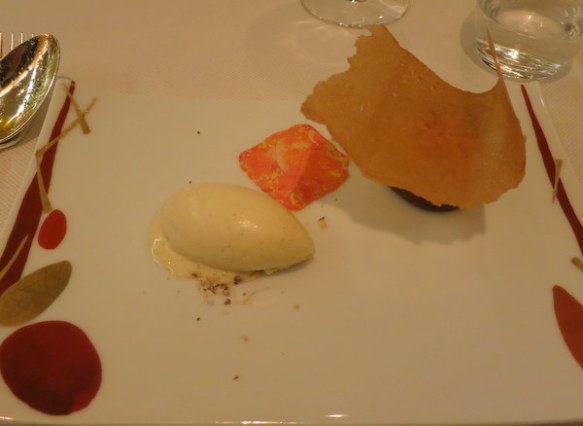
Surely the cookies had counted as dessert #1. There were supposed to be five desserts in total. Surely the gelato counted for one and the pastry counted for another, right? Wrong. The desserts kept coming, and we slowed down so much that we started getting two at once. The cookies hadn’t even counted as part of the five.
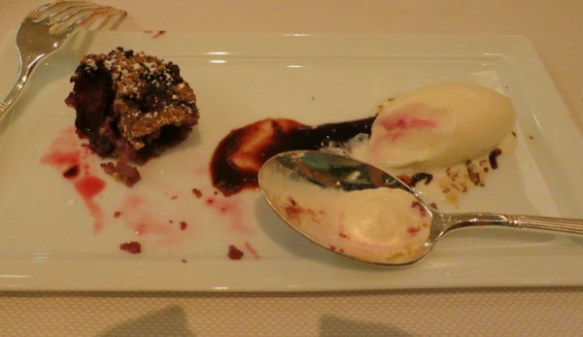
Not only that, but the kids had gotten (included) a dessert of their own, so they couldn’t help us out so much. Still, we were determined to do our duty and eat every bite. On top of the five desserts + cookies + cheese course, there was a tiny truffle course where we could choose our own adventure. How could we say no?
At one point I said, “If they bring another dessert, I’m going to cry,” and we all started laughing, on the verge of breaking the Code of Near-Silence.
Finally we ate our way through the last plate, now having finished enough dessert for about ten people. The last plate was probably my favorite, some kind of cherry cake (pictured above). We rolled out, giggling to ourselves.
My son said the other day, “Let’s never take the circus of desserts next time.” Amen. Maybe just 1/10 of it.
Below is a picture of one of the children’s desserts.

And in case you’re wondering yes, I threw the whole gluten-free eating thing out the window that week. I paid for it the next week, but it was well worth it!


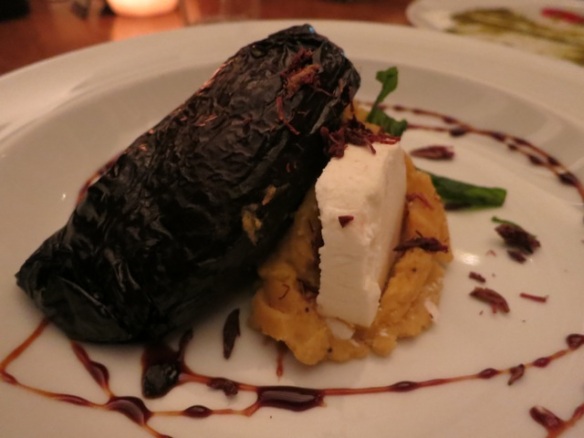
So, the secret destination I mentioned earlier was Oaxaca (say “wah-HOCK-ah”), Mexico. I love this city! I had visited once 15 years ago and always dreamed of going back.
The capital city of the state of Oaxaca, it’s like a jewel-box deep in heart of the southern mountains of Mexico, full of stunning architecture, intricate handicrafts, and oh yes, fantastic food.
The top photo was my first meal there, an ancho chile relleno next to plaintain mash with Oaxacan cheese. Surprisingly, it was actually a lot prettier than it was flavorful, but I enjoyed trying it anyway.
Below are the appetizers from that night, including, from the back of the slate platter, cheese, guacamole, and chapulinas. Chapulinas are a Oaxacan specialty—roasted grasshoppers!
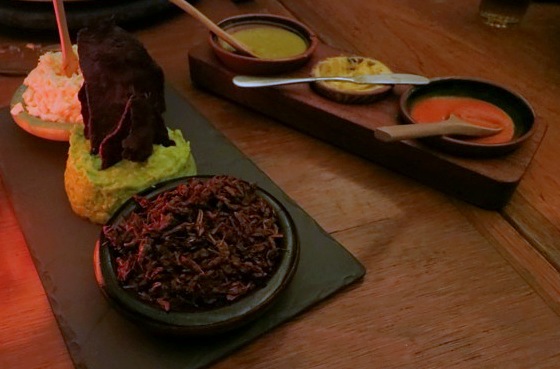
Our Mexican friends told us that if you eat one, it means you get to come back to Oaxaca. It would be a lie to say they’re my favorite dish, but I was super glad I DID eat one 15 years ago. So glad, in fact, that I ate several more, hoping I will for sure get to visit again.
Below you see chiles drying at a restaurant where we ate lunch. The set up was unusual—you walk through the kitchen area up to the roof to eat. Sadly I didn’t take pics of the wonderful chicken red mole enchiladas I had.
Mole is a type of sauce involving many ingredients, including cocoa, which was first cultivated in ancient Mesoamerica. There are many different kinds of mole, and they’re not at all sweet, so don’t worry, it’s not at all like eating candy on your meat.
From the rooftop of the lunch restaurant, there’s a view of the historic Santo Domingo church, and we had great seats to see a traditional wedding celebration going out of the church, complete with dancers, costumes, and these enormous puppets that lead the way to the reception.
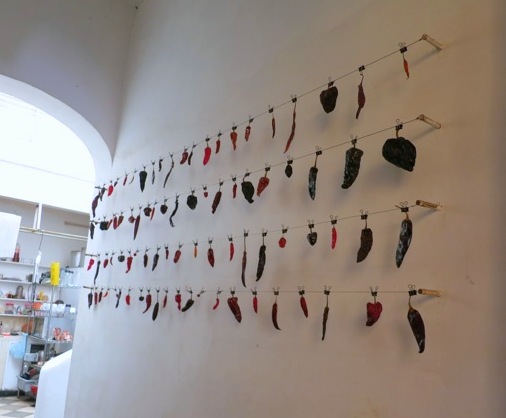
Lastly, here’s a photo (from the same location) of Caldo de Piedra, or “Stone Soup.” I couldn’t actually eat it, since I can’t do shellfish, but it was fascinating to watch our chef cook it, tableside.
The rocks were heated to such a high degree that when they were placed in the bowls of raw food (shellfish and broth, veggies), the liquid immediately boiled like mad. After a few moments, the liquid cooled a bit, and the chef removed the first stones and added a second hot stone to each bowl.

If you look closely, you can see the beautiful handcarving on the bowls, which are made of what I gather is a kind of gourd.
Delicious foods not pictured: duck tacos, Oaxacan tamales (wrapped in banana leaves), hot chocolate, and eggs smothered in fantastic sauces. Breakfast was not to be missed.
More on Oaxaca to come. Hope you have a great weekend. It’s like 75 degrees here today. I can’t believe it’s December!



By:
Paintgranny,
on 12/6/2007
Blog:
Middle of Nowhere
(
Login to Add to MyJacketFlap)
JacketFlap tags:
Poppy letterpress,
Andy English,
Incline Press,
Satsuma Press,
Alan Brignull,
Adanaland,
Moontree Letterpress,
Snap and Tumble,
polymer blocks,
Graham Moss,
Alan Brignull,
Poppy letterpress,
Andy English,
Incline Press,
Satsuma Press,
Adanaland,
Moontree Letterpress,
Snap and Tumble,
polymer blocks,
Graham Moss,
Fine Press Book Association,
Fine Press Book Association,
Add a tag
Feeling a little jaded, tired and grumpy, I have nothing of note to record and my hands are cold. Let me take you back through the mists of time, to far off November, when I escaped the village by coercing Andy to bike me over to the Fine Press Book Fair in Oxford. It was somewhat overwhelming; spending much of my time alone, and rarely going anywhere of cultural interest, I was staggered by the atmosphere of bustling bookishness. At the same time, I felt completely at home, and had a few pleasant potters round the hall with a big dopey grin on my face, for no particular reason apart from being surrounded by gorgeous books, prints, papers and letterpress stands. Several names I recognised, and I was hoping to say hello to a couple of contacts I'd made through that brash (but oh-so-invaluable-for-hermits) newcomer, the internet. I spotted Andy English at once, though not knowing him at all, I hung back from saying 'hello, I know you through Sue's blog'. Which might have sounded a bit - well, weird. When he was not chatting to customers, he was bent over his little cushion thingy, working on one of his blocks. That's him in the foreground, to the right of the lady in the maroon top. He has also done a very good blog post of his own about the fair, with much better photos. 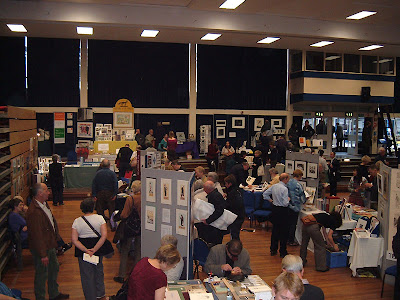
I eventually managed to find Alan Brignull, who runs the Hedgehog Press, (no website, alas) and produces his very own Adanaland stamps. After a few weeks of emails, we finally got to shake hands and say hello - I had bought him a humble offering of some of my cards, and he had kindly brought me some spare parts for my miniature Adana, which is sadly falling to bits. After a chat, we parted company, and I beetled off to find the Incline Press, another grapevine contact. One of those times when you have to say 'hi, we've never met in person but...' and so I became acquainted with the lovely Graham and Kathy who produce the most gorgeous books and whose stall was buzzing with a little crowd of admirers.

When they were busy with punters, I took the opportunity to take some pictures of their beautiful creations-
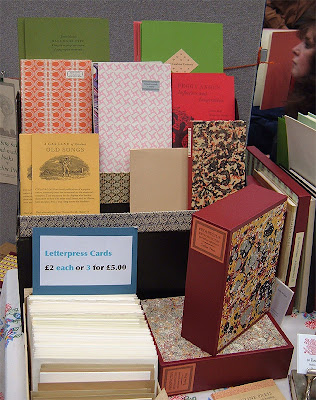
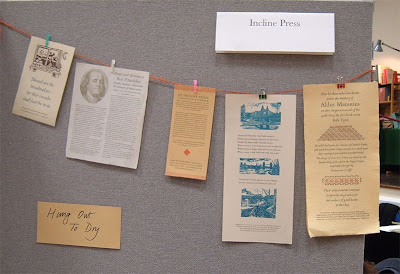

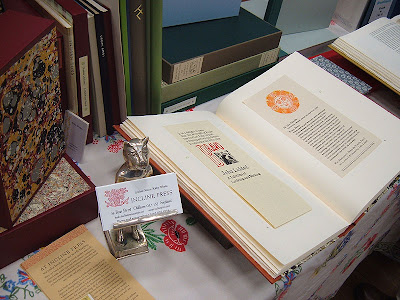
Some great advice was had from Graham and I realised not for the first time what a tiny and tightly connected world the UK letterpress community is.

Apart from learning the hard way how not to approach a print job, I now realise that what I want to do with my printing is a hundred years away from the kind of amazing craftsmanship I witnessed at the Book Fair. I am going off into the gift stationary side of things, which will involve such heresies as polymer plates and impressioning the card stock (which, believe me, can produce extraordinary - and even vitriolic - reactions in the extreme, traditional branches of the letterpress community). But I am more interested in the end product rather than the process, so I will leave the professional stuff to the professionals. In the meantime, I have found some lovely printing blogs, which are full of stunning work and useful tips - so if you are interested in 21st century letterpress and you don't get high blood pressure from seeing polymer block work or impressed stock, then pop over to - Snap and Tumble, Satsuma Press, Moontree Letterpress, and Poppy Letterpress. Enjoy.





















Oh how fun! I totally would have eaten every bite as well!:-)
I’m ready to explode just reading about it and seeing the photos…bon appetit had by all. What better way to vaycay!
Thanks, Donna! It was definitely a memorable night.
Yes, that was really the only thing to do :)